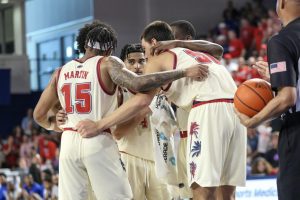SPORTS
University of Florida, Florida State University and University of Miami are unquestionably the three powerhouse athletic programs of the Sunshine State. And while these three schools remain Florida’s top dogs, FAU believes it is not too far behind.
Under the National Collegiate Athletic Association (NCAA) rules, universities must have at least 16 sports to be labeled a Division I school. FAU currently has 18, which, in comparison, is the same amount as UM.
To even the most casual of fans, however, FAU doesn’t seem to match up. FAU Athletic Director Craig Angelos believes otherwise.
“Our athletic program is as big as Miami’s and as big as Florida State’s,” said Angelos. “We have the same number of scholarships, probably more. Same number of athletes, probably more. But they live in the Atlantic Coast Conference [ACC], and we live in the [weaker] Sun Belt Conference.”
The Sun Belt doesn’t get the television coverage that more prestigious conferences, such as the ACC, get. Schools in the Sun Belt fight for coverage and money. With that being the case, FAU is limited to what it can do when expanding its athletic program.
Before football arrived to FAU in 2001, baseball brought in the most athletes, fans and money. But like most major schools spanning the nation, football eventually became the biggest draw.
What gained FAU some national attention was when prolific head coach Howard Schnellenberger and the football team won a bowl game within the first three years of becoming a Division I program, defeating the Memphis Tigers 44-27 in the New Orleans Bowl in 2007. That victory made FAU the youngest football program in the history of the NCAA to achieve such a feat, and placed a small but important blip on the college football radar for the university.
“I don’t think anybody has grown a program faster than we have, just by the numbers,” said Angelos. “We are like a startup company trying to rise faster and catch up.”
Even though FAU has made significant progress over the past few years, it still lacks one important, basic fundamental: tradition. FAU is behind in that area, but Angelos is optimistic about the university’s future.
“You want to have facilities and traditions. One or the other, but preferably both,” said Angelos. “We have a good population base to draw from here. I wouldn’t be surprised if in 10 years we have enough of a fan base to compete with Miami.”
The future of the FAU athletics program lies in the plans of a brand-new football stadium, complete with athlete living space. Modeled
after the University of Central Florida football stadium, construction will begin on FAU’s stadium by June 1 of this year, and it is expected to host its first football game on Sept. 17, 2011.
If all goes as planned with the stadium, FAU will be one step closer to achieving the national recognition it so desires.
How they stack up
Some of the state universities’ win and loss totals in men’s baseball, basketball and football in 2009
FAU
Baseball: 30-26
Basketball: 6-26
Football: 5-7
UM
Baseball: 38-22
Basketball: 19-13
Football: 9-4
UF
Baseball: 42-22
Basketball: 25-11
Football: 13-1
FSU
Baseball: 45-18
Basketball: 25-10
Football: 7-6
USF
Baseball: 34-25
Basketball: 9-22
Football: 8-5
UCF
Baseball: 22-35
Basketball: 17-14
Football: 8-5
FIU
Baseball: 34-22
Basketball: 13-20
Football: 3-9











